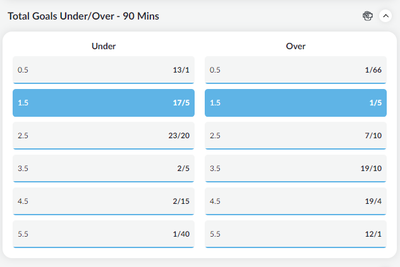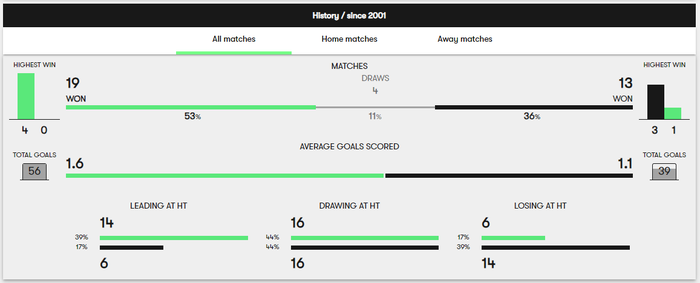 Lots of football bets focus in one way or another on goals, for the obvious reason that they are the most important factor in football. There are lots of different bets for which goals are key, including the most popular of them all, the match result.
Lots of football bets focus in one way or another on goals, for the obvious reason that they are the most important factor in football. There are lots of different bets for which goals are key, including the most popular of them all, the match result.
However, other wagers are more directly dependent on goals and in particular the number of them that are scored in the whole game. One of the most popular of those is betting on whether a game will see over – or alternatively under – 2.5 goals. We have a separate article on that which covers much of what we will look at here, but in greater depth.
If you specifically want to know about the under/over 1.5 goals market and are happy with a more concise feature, keep reading. We’ve also got some stats as well as strategies that are solely relevant to the alternative 1.5 line.
Over or Under 1.5 Goals Betting

This is a binary bet, by which we mean the market has two outcomes, so you are deciding between two picks when you make a bet. You either opt for over 1.5 goals, or under 1.5 goals. Any game that sees two or more goals is a win for the former, whilst any game with one or zero goals is a win for unders. There is not too much more to add and this is very straightforward market; its simplicity is part of its appeal.
The “normal” under/over 1.5 goal market will always apply to 90 minutes and injury time only. Extra time and penalties do not count, so it is the number of goals at full time that are all-important to this bet. Own goals, penalties for fouls in normal time, screamers from 45 yards and ones that hit the striker’s backside before trickling over the line through a player’s legs all count exactly the same. In short, the market is settled on the official score at the end of normal time. 0-0 or 1-0 (to either side) is a win for under 1.5 goals, whilst any other score, be that 1-1, 2-0, or 100-99 (what a game that would be, by the way!), means wagers on over 1.5 goals will be paid by the bookies.
Why is it 1.5 Goals, Not 1?
This is a topic we cover in more depth in our feature on over/under 2.5 goals but in short, it is simply to make the market simpler to understand. In theory the bet could be “Two goals or more, or one goal or fewer”, or “Over 1 goal – yes or no”. However, the former is rather long-winded, whilst the latter, though clear enough really, could leave some room for doubt about what happens if exactly one goal is scored. Using the half goal removes all doubt and confusion and makes it a clear binary choice, expressed as simply and concisely as possible.
What is the Most Common Outcome?

As a general rule, most games see somewhere around 2.60 goals on average. Obviously you can’t score 0.6 goals but what this means in reality is that lots of games either witness two goals or three, and overall the average is slightly higher than two and a half. That does not, per se, mean that more matches see over 2.5 goals than under, because of course the lower end of the goals spectrum is restricted to zero, whilst the upper limit for goals is theoretically infinite and in reality around 10. That said, the stats show us that in most leagues, in recent times, slightly more matches have over 2.5 than under.
You can see more on this in our over/under 2.5 goals article, but over the last 10 years in the Premier League, the figures are around 48% for under 2.5 goals and 52% for over. The fact that over/under 2.5 goals offers two choices, with relatively equal chances of occurring, is part of the appeal of that bet. Most of the time, though with exceptions, whether you opt to back unders or overs, you will probably get odds not too far away from evens, whilst also having a good shot at winning your bet.
The upshot of this is that the stats are not so equal when it comes to over/under 1.5 goals. Unsurprisingly, under 1.5 goals occurs far less frequently than over and consequently there is usually a greater divergence in the odds. We will look at the stats and example odds shortly but because this is less of a 50/50 bet, it tends to be far less common, and less popular, than backing over or under 2.5 goals. That is not to say it is a strange, unusual, or complex wager, but far more money is gambled on the higher, “standard” line of 2.5 goals.
Stats

So, having said that over 1.5 goals is far more common than under 1.5 goals, what exactly do the stats show us about this market? Well, restricting our focus to the Premier League, we can see that in the 2021/22 season an average of 2.82 goals were scored per match. In 293 games, over 1.5 goals was the winning wager, meaning overs came in over 77% of the time. Under 1.5 goals occurred in 87 clashes, or just shy of 23% of the time.
Looking at the season before that, we saw slightly fewer goals scored in total, with 2.69 on average. This equated to over 1.5 goals only being scored 73.42% of the time, versus 26.58% for under 1.5. In 2019/20 those figures changed to 80% overs and 20% unders, with the campaign prior to that seeing similar numbers of 79.74% and 20.26%. There is not too much deviation from those sorts of figures either, with 2017/18 seeing a 74%/26% split and 2016/17 77% and 23%.
So in this period of time under 1.5 goals has occurred between 20% and almost 27% of the time. Two goals or more have been scored in between just over 73% and 80% of matches. This is broadly in line with what we see in most other leagues around the world and there has not been any major change in the frequency of overs/unders over the past 30 years or more. Put as simply as possible, approximately three in four games of football will see over 1.5 goals, whilst just one in four end either goalless or with just a single goal.
What Odds Will I Get?

The main way most punters use this market is if they either want a safer bet than over 2.5 goals, or alternatively predict a low-scoring clash and want to take more risk, and obtain better odds, than backing under 2.5. In almost all matches, over 1.5 goals will be priced at odds-on, whilst unders will be available at odds of over evens – often a good deal higher.
Let us look at the odds for the 2023 Nations League final and third/fourth-place play-off game. In the final Croatia played Spain, with the latter being firm favourites at odds of evens to win in 90 minutes and Croatia offered at 3/1 (draw 13/5). Over 1.5 goals was priced at 1/3, with under at odds of 12/5. The play-off game was between Netherlands (5/4) and Italy (2/1 – the draw was 5/2). In that clash, under 1.5 goals was 3/1, with the far more likely overs available at odds of just 1/4.
These odds are very typical, and what one would expect given the approximate frequency of overs occurring around 75% of the time and unders just 25%. With unders paying out at odds of between 2/1 and 3/1 most of the time, this can be a rewarding bet when you get it right. On the flip side, if you are looking for a “safe” bet (of course there is no such thing as a safe bet really!) then over 1.5 goals may well appeal. These are often added to accas, or alternatively can be used to qualify for certain offers or free bets – subject to any minimum odds requirements.
Important Rules
At the risk of repeating ourselves (twice) this is a simple market but for more thorough info regarding rules and key terms you can see our over/under 2.5 goals article. That said, the number one thing to note is that goals that come in extra time and/or a penalty shootout do not count as far as this market is concerned.
Betting Strategy

Yes – we are going to say it again: you can read more about strategy and tips for over/under betting in the feature that looks at 2.5 goals. Almost everything is the same so rather than give you all the same information again, let us look more specifically at strategy when considering the lower 1.5 line.
Much of this focuses on trying to find games for which under 1.5 goals is worth backing. Because if you are betting on over 1.5 goals then really you are simply relying on the same logic and reasoning as you would be for over 2.5 but just accepting lower odds for increased chance. In contrast, when trying to find a winner on under 1.5 goals you are looking to find a particularly low-scoring clash and if you do you could double or treble your stake – or even grow it by a larger amount.
Factoring in pressure is often important, as lots of very important games, which often take place between evenly matched sides (another major indicator of a low-scoring game), tend to end 0-0 or 1-0 either way. Games such as cup semis and finals, relegation six-pointers or clashes between sides competing for the title or top four, are all good ones to consider. This can be especially rewarding when the two teams are normally attacking and free-scoring because the odds will often be generous.
Another important factor, mentioned above, is to look mostly at fixtures between two relatively even sides. Where one team is far stronger there is a very good chance that they alone will score at least two goals and thus scupper any under 1.5 punt. That said, if the better side is away from home, and the hosts are likely to defend in numbers and be very satisfied with a draw, backing unders could prove very lucrative.
Again, the odds are likely to be big as most recreational punters will automatically assume that a team such as Manchester City or Arsenal will brush aside one of the relegation candidates. Both teams were very high scorers in 2022/23 but even so, six of City’s away games ended with under 1.5 goals scored. As for Arsenal, five of their away Premier League games ended with under 1.5 goals. Given this duo were far and away the league’s top scorers (with 94 and 88 goals respectively, and Liverpool third with 75), these under 1.5 goals numbers may surprise many.
